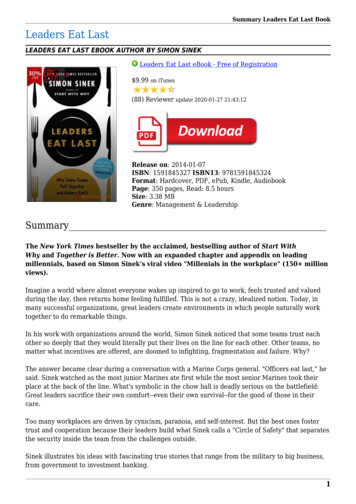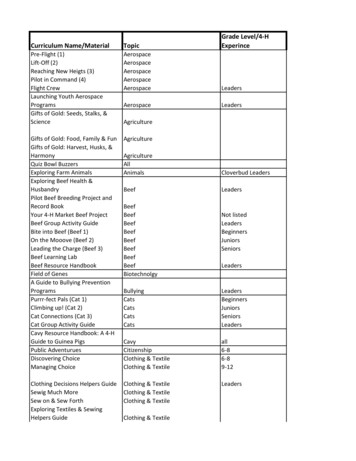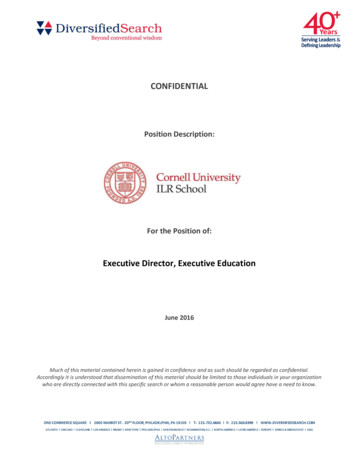
Transcription
School Leadership StudyExecutive SummaryPreparing School Leaders for a Changing WorldLessons from Exemplary Leadership Development ProgramsLinda Darling-HammondMichelle LaPointeDebra MeyersonMargaret Terry OrrExecutive SummaryStanford Educational Leadership Institute1Commissioned by The Wallace Foundation
Principals play a vital role in setting the direction for successful schools, but existingknowledge on the best ways to prepare and develop highly qualified candidates issparse. What are the essential elements of good leadership? What are the features ofeffective pre-service and in-service leadership development programs? Whatgovernance and financial policies are needed to sustain good programs? The SchoolLeadership Study: Developing Successful Principals is a major research effort that seeks toaddress these questions. Commissioned by The Wallace Foundation and undertakenby the Stanford Educational Leadership Institute in conjunction with The FinanceProject, the study examines eight exemplary pre- and in-service program modelsthat address key issues in developing strong leaders. Lessons from these exemplaryprograms may help other educational administration programs as they strive todevelop and support school leaders who can shape schools into vibrant learningcommunities.Citation: Darling-Hammond, L., LaPointe, M., Meyerson, D., & Orr, M. (2007).Preparing school leaders for a changing world: Executive summary. Stanford, CA:Stanford University, Stanford Educational Leadership Institute.The final report, Preparing School Leaders for a Changing World: Lessons from ExemplaryLeadership Development Programs, can be downloaded from http://seli.stanford.edu orhttp://srnleads.org.This report was commissioned by The Wallace Foundation and produced by the StanfordEducational Leadership Institute in conjunction with The Finance Project. 2007 Stanford Educational Leadership Institute (SELI). All rights reserved.
Getting Principal Preparation RightOur nation’s underperforming schools and children are unlikely to succeed until we get serious about leadership.As much as anyone in public education, it is the principal who is in a position to ensure that good teaching andlearning spreads beyond single classrooms, and that ineffective practices aren’t simply allowed to fester. Clearly,the quality of training principals receive before they assume their positions, and the continuing professionaldevelopment they get once they are hired and throughout their careers, has a lot to do with whether schoolleaders can meet the increasingly tough expectations of these jobs.Yet study after study has shown that the training principals typically receive in university programs and fromtheir own districts doesn’t do nearly enough to prepare them for their roles as leaders of learning. A staggering 80percent of superintendents and 69 percent of principals think that leadership training in schools of education isout of touch with the realities of today’s districts, according to a recent Public Agenda survey.That’s why this publication is such a milestone, and why The Wallace Foundation was so enthusiastic aboutcommissioning it. Here, finally, is not just another indictment, but a fact-filled set of case studies about exemplaryleader preparation programs from San Diego to the Mississippi Delta to the Bronx that are making a difference inthe performance of principals. The report describes how these programs differ from typical programs. It candidlylays out the costs of quality programs. It documents the results and offers practical lessons. And in doing so, itwill help policymakers in states and districts across the country make wise choices about how to make the most oftheir professional development resources based on evidence of effectiveness.Drawing on the findings and lessons from the case studies, the report powerfully confirms that training programsneed to be more selective in identifying promising leadership candidates as opposed to more open enrollment.They should put more emphasis on instructional leadership, do a better job of integrating theory and practice,and provide better preparation in working effectively with the school community. They should also offerinternships with hands-on leadership opportunities.Districts, for their part, need to recognize that the professional development of school leaders is not just a briefmoment in time that ends with graduation from a licensing program. This report contains practical examplesof how states, districts and universities have effectively collaborated to provide well-connected developmentopportunities that begin with well-crafted mentoring and extend throughout the careers of school leaders.Is training the whole answer to the school leadership challenge? Certainly not. The best-trained leaders in theworld are unlikely to succeed or last in a system that too often seems to conspire against them. It requires stateand district policies aimed at providing the conditions, the authority and the incentives leaders and their teamsneed to be successful in lifting the educational fortunes of all children. But better leadership training surely is anessential part of that mix. And that’s why this report is so welcome.M. Christine DeVitaPresident, The Wallace FoundationApril 2007
Preparing School Leaders for a Changing World:Lessons from Exemplary LeadershipDevelopment ProgramsExecutive SummaryTBy Linda Darling-Hammond, Michelle LaPointe, Debra Meyerson, and Margaret Terry OrrIn collaboration with Margaret Barber, Carol Cohen, Kimberley Dailey, Stephen Davis,Joseph Flessa, Joseph Murphy, Ray Pecheone, and Naida Tushnetremendous expectations have been placed on school leaders to cure the ills facing the nation’s schools.The critical part principals play in developing successful schools has been well established by researchersover the last two decades: committed leaders who understand instruction and can develop the capacities ofteachers and of schools are key to improving educational outcomes for all students. With these hopes for thepotential of school leaders has come a surge of investment in and scrutiny of programs that recruit, prepare,and develop principals.Contemporary school administrators play a daunting array of roles. They must be educational visionaries and changeagents, instructional leaders, curriculum and assessment experts, budget analysts, facility managers, special programadministrators, and community builders. New expectations for schools — that they successfully teach a broad rangeof students with different needs, while steadily improving achievement for all students — mean that schools typicallymust be redesigned rather than merely administered. It follows that principals also need a sophisticated understandingof organizations and organizational change. Further, as approaches to funding schools change, principals are expectedto make sound resource allocations that are likely to improve achievement for students.Knowing that this kind of leadership matters is one thing, but developing it on a wide scale is quite another. Whatdo we know about how to prepare principals who can successfully transform schools? What is the current status ofleadership development? And how might states systematically support the development of leaders whose schools areincreasingly successful in teaching all students well?This report addresses these questions using data from a nationwide study of principal development programs and thepolicies that influence them. In 2003, with funding from The Wallace Foundation, the Stanford EducationalLeadership Institute, in collaboration with the Finance Project, began to study how exemplary preparation andprofessional development programs develop strong school leaders. We sought to determine whether some programsare more reliably effective in producing strong school leaders, and if so, why and how? What program componentsand design features do effective programs share? How much do these programs cost? How are they supported andconstrained by policies and funding streams?Executive Summary1
TThe Studyhe study examined eight exemplary pre- and in-service principal development programs. The programs werechosen both because they provided evidence of strong outcomes in preparing school leaders and because, incombination, they represented a variety of approaches, designs, policy contexts, and partnerships betweenuniversities and school districts. Pre-service programs were sponsored by four universities: Bank Street College;Delta State University; the University of Connecticut; and the University of San Diego, working with the SanDiego Unified School District. In-service programs were sponsored by the Hartford (CT) School District, JeffersonCounty (KY) Public Schools (which included a pre-service component), Region 1 in New York City, and San DiegoUnified Schools. In several cases, pre- and in-service programs created a continuum of coherent learning opportunitiesfor school leaders (see Table 1).To understand how the programs operate and how they are funded, we interviewed program faculty and administrators, participants and graduates, district personnel, and other stakeholders. We reviewed program documents andobserved meetings, courses, and workshops. We surveyed program participants and graduates about their preparation,practices, and attitudes, comparing their responses to those of a national random sample of principals. In addition, foreach program, we observed graduates in their jobs as principals, interviewed and surveyed the teachers withwhom they work, and examined data on school practices and achievement trends.1We triangulated data from all of these sources in drawing conclusions. However, most of the findings represented in this reportderive from self-reported data from candidates, principals, and program faculty, along with our observations of program activitiesin selected schools.12School Leadership Study
Table 1: Description of Program SamplePre-serviceProgramsIn-serviceProgramsProgram DescriptionsDelta State University(MS)Delta State overhauled its program to focus on instructional leadership, featuring a full-time internship and financial support soteachers can spend a year preparing to become principals who cantransform schools in a poor, mostly rural region. The program benefits from support from local districts and the state of Mississippi.University of ConnectThe UCAPP program is transforming a high-quality, traditionalicut’s Administratoruniversity-based program into an innovative program that increasPreparation Programingly integrates graduate coursework and field experiences and(UCAPP)prepares principals who can use data and evidence of classroompractice to organize change. Some candidates go into Hartford, CT,where they receive additional, intensive professional development.Hartford (CT) Public The LEAD Initiative has used leadership development to leverageSchool Districtreforms vital to moving beyond a state takeover. Working with theInstitute for Learning at the University of Pittsburgh, Hartford isseeking to create a common language and practices around instructional leadership.The Principal’s Institute Region 1 of the NYC Working with Bank Street College, Region 1 has developed a conat Bank Street College Public Schoolstinuum of leadership preparation, including pre-service, induction,(NY)and in-service support. This continuum aims to create leadershipfor improved teaching and learning closely linked to the district’sinstructional reforms.Jefferson County (KY) Jefferson CountyBeginning in the late 1980s, JCPS has developed a leadershipPublic Schools(KY) Public Schools development program tailored to the needs of principals workingin the district. Working with the University of Louisville, JCPS hascrafted a pathway from the classroom to the principalship and awide array of supports for practicing leaders.Educational Leadership San Diego (CA)San Diego’s continuum of leadership preparation and developmentDevelopmentUnified Schoolreflects a closely aligned partnership between SDUSD and ELDA.Academy (ELDA) atDistrict (SDUSD)The pre-service and in-service programs support the developmentthe University of Sanof leaders within a context of district instructional reform by focusDiegoing on instructional leadership that is supported by a strong internship, coaching and networking.We conducted policy case studies in the states represented by the program sample — California, Connecticut, Kentucky, Mississippi, and New York; these were augmented by data from three additional states that had enacted innovative leadership policies — Delaware, Georgia, and North Carolina. This provided us a broader perspective onhow state policy and financing structures influence program financing, design, and orientation. In these eight states,we reviewed policy documents and literature and interviewed stakeholders: policymakers and analysts; principals andsuperintendents; and representatives of professional associations, preparation programs, and professional developmentprograms. Our national survey over-sampled principals from these states to allow state-level analyses of principals’learning experiences, preparedness, practices, and attitudes in relationship to policy contexts.From these analyses, we describe what exemplary leadership development programs do and what they cost; what theiroutcomes are for principals’ knowledge, skills, and practices; and how policy contexts influence them. We also describea range of state policy approaches to leadership development, examining evidence about how these approaches shapeopportunities for principal learning and school improvement.Executive Summary3
In the Words of GraduatesParticipants and graduates were quick to identify the strengths of their programs. These often centered on the tight integration of coursework and clinical learning experiences:The internship experience is phenomenal. Wereally got to see schools,because we were given anopportunity to experiencean internship that put youin the school and had youworking with a principaldoing things for the school— not just sitting aroundhearing about it. You’reactually doing it, and— San Diego ELDA that was one of the benintern principal efits of this program. . . .It’s authentic. [We had]authentic experiences thathelped us learn, so we hadnot only an opportunity todiscuss it through classes,but we experienced itthrough doing.I think the program isstructured in a way thatmakes you think critically.You are constantly connecting what you learned inthe past to the real world. Ithink that is important. Alot of programs are designed to just get through,and at the end you get amaster’s or a certificate, butthis program truly preparesyou to become an effective leader. They do thisthrough seminars, throughvisits to other schools, [andthrough your internship].You get to see what reallyoccurs in the schools, andwhat it really takes to become an effective leader.— UCAPP graduate— Bank Street graduateI thought it was just brilliant to combine the theoryand practice. I like that theprogram has been modeledaround learning theory. Ilike the fact that our classesare germane to what is going on daily in our school.It really helps to make thelearning deeper and, obviously, more comprehensive.4School Leadership StudyWe didn’t learn by sittingin a classroom, reading outof a textbook, and listening to a lecture every day.That’s not how we learnedeverything. Once we gotinto our internship, all thetheories and discussionsof change and leadershipstyles came into play. Sowhat we learned was nota result of reading out ofa textbook and sitting ina class taking notes, it’sbecause of the interaction that we had with ourprofessor and what we’vebeen able to discuss sincewe’ve been out into ourinternship.— Delta State Universitygraduate
mThe Findingsuch of the literature about leadership development programs describes program features believed tobe productive, but evidence about what graduates of these programs can actually do as a result of theirtraining has been sparse. We designed our research around the view that exemplary programs shouldoffer visible evidence that they affect principals’ knowledge, skills, and practices, as well as success intheir challenging jobs. Comments about the abilities of graduates of the programs we studied — madeby employers, colleagues, and the graduates themselves — suggested that something distinctive was going on in theseprograms:[ELDA graduates] take hold in a way that I don’t have the same confidence others could. They can articulatea belief and build a rationale and justification that encourages others to believe the same thing and hold highexpectations for all kids. I have confidence with the ELDA graduates that the belief doesn’t become wordsthat float away in the air — that they put actions behind it, convincing others not by edict, but by actualleadership. . .looking at practice, figuring out what to do about it, and not settling for practice that doesn’tproduce a good result for kids.— San Diego Unified School District principal supervisorAs a superintendent, I hired a couple of principals out of [the UCAPP program], and these people wouldcome to the table when we were at administrative council meetings and they knew how to disaggregate data,they knew how to use data, they knew about school improvement plans, they knew about how you effectivelyevaluate staff; I mean, they came in and they were ready to go to work!— Local superintendent in ConnecticutI could always tell when I was doing my interviews who had gone to Principals for Tomorrow and whohadn’t. I could tell based on the questions: who knew [how to lead] and who didn’t.— Jefferson County Public Schools human resources managerIndeed, we found that graduates of these innovative programs report higher quality program practices, feel betterprepared, feel better about the principalship as a job and a vocation, and enact more effective leadership practices thanprincipals with more conventional preparation.1. Exemplary pre- and in-service programs share many common featuresAlthough we selected programs as exemplars of different models operating in distinctive contexts, we found common elements among them that confirm much prior research on productive design features. We also uncovered someimportant program components and facilitating conditions, especially the importance of recruitment and financialsupports, that have received less attention in the literature.Executive Summary5
Pre-Service ProgramsAll of the pre-service programs in our sample shared the following elements: A comprehensive and coherent curriculum aligned with state and professional standards, in particular theISSLC standards, which emphasize instructional leadership; A philosophy and curriculum emphasizing instructional leadership and school improvement; Active, student-centered instruction that integrates theory and practice and stimulates reflection. Instructionalstrategies include problem-based learning; action research; field-based projects; journal writing; and portfoliosthat feature substantial use of feedback and assessment by peers, faculty, and the candidates themselves; Faculty who are knowledgeable in their subject areas, including both university professors and practitionersexperienced in school administration; Social and professional support in the form of a cohort structure and formalized mentoring and advising byexpert principals; Vigorous, targeted recruitment and selection to seek out expert teachers with leadership potential; and Well-designed and supervised administrative internships that allow candidates to engage in leadership responsibilities for substantial periods of time under the tutelage of expert veterans.Some of these features had spillover effects beyond the program itself. For example, cohort groups became the basis ofa peer network that principals relied on for social and professional support throughout their careers. Strong relationships with mentors and advisors also often continued to provide support to principals after they had left the program.As one of the principals we followed explained:I call a lot on my cohort friends from Bank Street. . . . We bounce frustrations as well as successes and questions off each other. And I’ll have colleagues call me back [with] a question when they need an answer tosomething. Hopefully, we can provide it. When there are new principals, I try to reach out with that sense ofmy responsibility.A Delta State graduate described how the cohort provides a broad network of support:Anytime I need any one of them or they need me, I can pick up to the phone or e-mail. . . . That is great. Iknow that there are different strengths that these people have. You go back and you draw from them and say,“I know this. She knows this person, she knows that person.”And a Connecticut superintendent suggested that the UCAPP program’s cohort system prepares principals for the collaborative necessities of today’s schools:I think one of the real strengths is the cohort model that they use. It’s amazing how these people function asa team and help one another. . . . And I think that’s important, because if you’re going to be an educationalleader in this day and age, you can’t function in isolation. The only way you can operate and do a good job isto function as a team.Other features had strong enabling influences on what the programs could accomplish. In particular, the programsspecifically reached out to candidates who had backgrounds that would allow them to become strong instructional6School Leadership Study
leaders. Rather than waiting to see who would enroll, the programsworked with districts to recruit candidates who were known asexcellent teachers with strong leadership potential and who reflected the local population of teachers and students. Thus, in theaggregate, graduates were significantly more likely than membersof the comparison group to be female and members of a racial/ethnic minority group. They were also much more likely to havestrong and relevant teaching experience, having frequently servedas coaches for other teachers, department chairs, and team leaders.These candidates were committed to their communities and capableof becoming instructionally grounded, transformative leaders.Finally, the nature of the internship — and its connection tocoursework — proved critically important to helping principalslearn to implement sophisticated practices. All of the programs westudied worked hard to develop productive internship experiencesand to integrate internships with coursework. Two of the programs we studied — Delta State and San Diego’s ELDA — offeredfull-year, paid administrative internships with expert principals,financed by the State of Mississippi in one case and by San Diegocity schools through a foundation grant in the other. These representthe most highly developed internships we studied, and the qualityof the experience was clearly reflected in graduates’ program evaluations and practices. While the graduates of all the programs reportedrelatively strong internships, those who had full-time, funded learningexperiences rated their programs most positively.In-Service Professional DevelopmentWe found that the exemplary in-service programs offered a well connected set of learning opportunities that were informed by a coherentview of teaching and learning, grounded in both theory and practice.Rather than offering an array of disparate and ever-changing, oneshot workshops, these programs had a clear model of instructionalleadership. They organized continuous learning aimed at the specificprofessional practices the model requires. These practices typically included developing shared, school-wide goals and direction, observingand providing feedback to teachers, planning professional development and other learning experiences for teachers, using data to guideschool improvement, and managing a change process. In additionto offering extensive, high-quality learning opportunities focused oncurriculum and instruction, the programs typically offered supportsin the form of mentoring, participation in principals’ networks andstudy groups, collegial school visits, and peer coaching. Three featurescharacterized districts’ efforts:Rather than waiting to see whowould enroll, the programs workedwith districts to recruit candidateswho were known as excellentteachers with strong leadershippotential and who reflected thelocal population of teachers andstudents. A learning continuum that operated systematically frompre-service preparation through induction and continuingcareers and included using mature and retired principals asmentors;Executive Summary7
Learning Leadership Practice in PracticeIn the districts we studied, much of school leaders’ professional learning is grounded in analyses of classroom practice and teacher development. Three of the districts — Hartford, New York City’s Region 1, andSan Diego — use regular principals’ conferences to anchor this learning.These are tied to school visits, coaching, and other supports for implementing new practices.In Region 1, for example, local instructional superintendents and their leadership teams, consisting of selectprincipals, instructional specialists, and English language learner coaches, meet monthly with staff from theUniversity of Pittsburgh’s Institute for Learning (IFL) for targeted professional development. These leaders subsequently meet with principals from their networks to disseminate what they’ve learned, sometimesreplicating parts of the IFL workshops.During one of our visits, we observed a day-long session led by IFL staff focused on “accountable talk,” ateaching practice the district was trying to develop in classrooms. School leaders were being taught to helpteachers learn how to facilitate students’ use of strong reasoning and discipline-appropriate evidence, such asproofs in mathematics, data from investigations in science, and textual details in literature.The session began with questions from principals who had tried previously to introduce the concept toteachers in their schools. The IFL staff then focused the discussion on the application of accountable talkin mathematics instruction, eventually breaking the group into subgroups to code examples of this talk intranscripts of teaching sessions. After debriefing the exercise, the subgroups were presented a math problemto solve in their small groups while IFL staff circulated in order to help participants reflect on their thinkingprocesses and support those who were stuck. The problem-solving exercise, which produced intense conversations in the groups, was followed by a debriefing intended to link the principals’ experience to studentlearning, specifically to drive home the challenges that some students face in learning math. The sessionclosed with an in-depth discussion of how each group would translate what they had learned to the principals in their immediate networks.The next month, these ideas were brought to the larger group, which includes all principals and one assistant principal or lead teacher from each school. Experienced principals and a local instructional superintendent (LIS) who had participated in the initial training session facilitated the meeting, beginning with aset of video clips of some typical classrooms. Participants worked in small groups with the video to identifyinstances of accountable talk and to differentiate instruction that was teacher-directed from that which wasstudent-centered. Participants also discussed ways to develop critical thinking in mathematics and engagedin an exercise that enabled the principals to solve a problem and reflect on their own discussion of solutionsin light of the notion of accountable talk. The subgroups of principals also coded a common transcript ofteaching to identify the language teachers used to support students in presenting and justifying their thinking.After debriefing this exercise, the principals discussed strategies they could each use to promote the practiceof accountable talk in their schools, highlighting the potential impact of observing videotapes of real teaching. The LIS who attended the sessions encouraged principals to videotape their teachers and to work withthem to analyze their talk. Throughout, she stressed the importance of principals and teachers reflecting ontheir practice and closed by distributing several books that would provide grist for future work on improving instruction.8School Leadership Study
Leadership learning that is organized around a model of leadership and grounded in practice, includinganalyses of classroom practice, supervision, and professional development using on-the-job observations connected to readings and discussions; and Collegial learning networks, such as principals’ networks, study groups, and mentoring or peer coaching,that offer communities of practice and support for problem-solving.These features were mutually reinforcing. For example, a San Diego principal described opportunities to developgrounded practice through the district-organized principal network:We’ve gone to each other’s campuses; we’ve had wonderful discussions; we’ve read books together. We’vewatched each other’s staff development tapes and talked about what we could do better, what kinds of thingswe think would help the staff move.A New York City Region 1 principal described how the district-operated principals’ network provided both a forumfor the exchange of ideas and a springboard for follow-up school visits and problem solving:We got a chance to sit with our networks and bring in our work and see other principals’ ideas. [These people]have been principals longer then I have, [and] have a lot more to share. So I’m always asking, “How did youdo that?” or, “Can I come to your school and see that?” And they are always open and willing.The principals from
Executive Summary 1 Preparing School Leaders for a Changing World School Leadership Study Executive Summary Lessons from Exemplary Leadership Development Programs sT a n F o rd ed u C a T oi n a l le a d e r s hpi ins T i T u T e Commissioned by Th e Wa l l a C e Fo u n d a T oi n lni d a da r lni g-ha m m o n d mi C helle laponi T e debra meyerson










